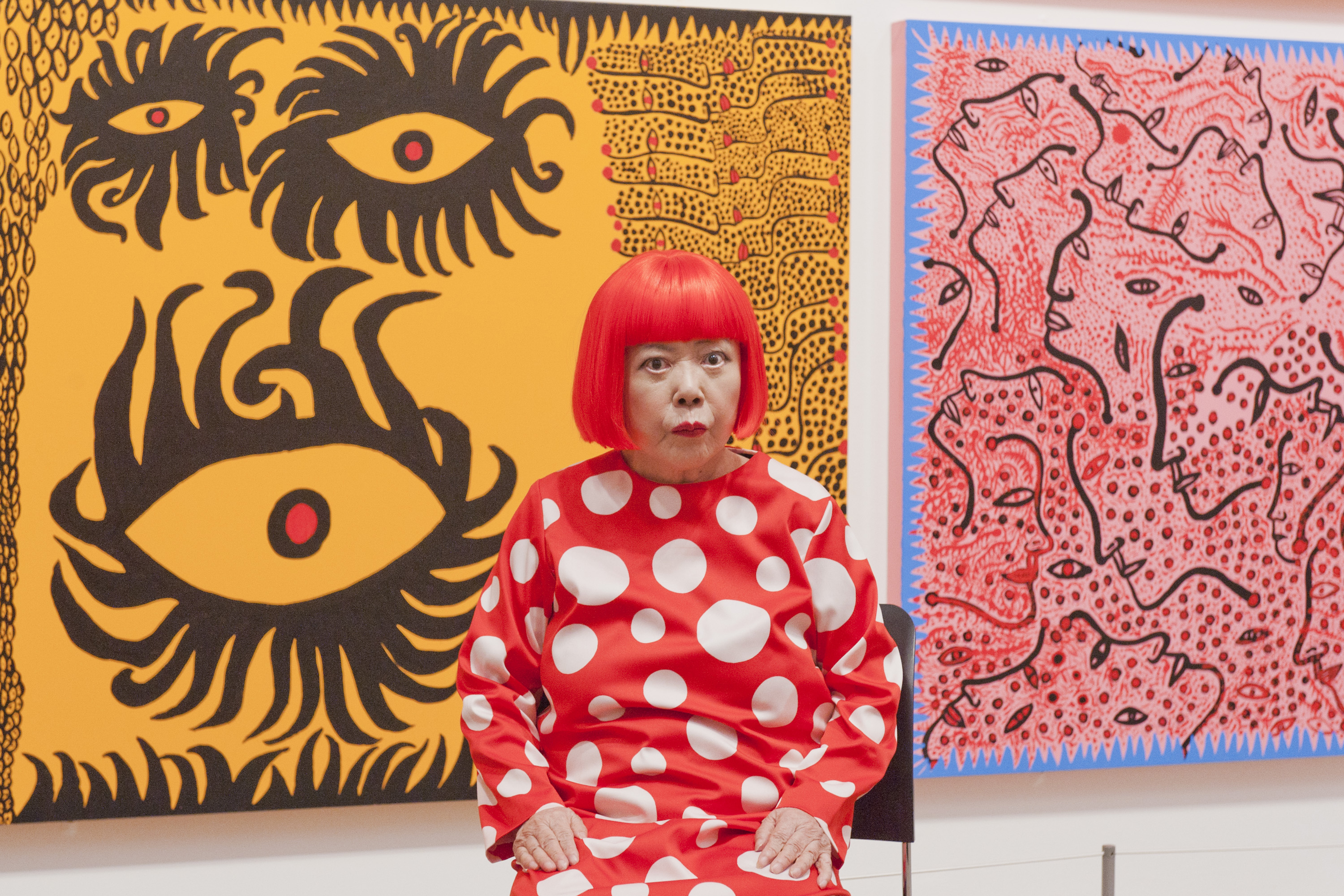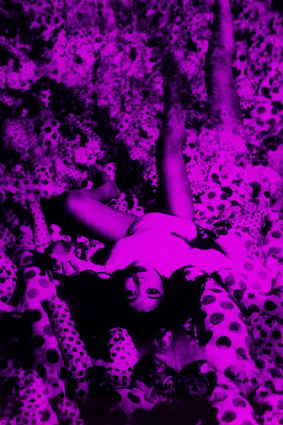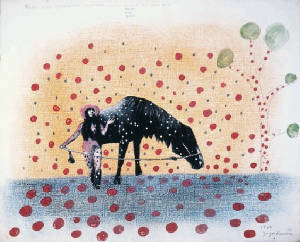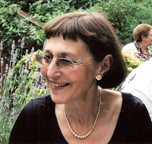  |
 |
 |
 |
|
theartsection
|
 |
|
 |
|
|
 |
|
Yayoi Kusama at Tate Modern

|
| Yayoi Kusama. Photo: Lucy Dawkins/Tate Photography. |
In 1977 Kusama decided to voluntarily admit herself
to a psychiatric hospital where she has remained to this day. Initially it provided her with the security and support she
needed especially when on her return to Japan the panic attacks and hallucinations she had suffered as a child returned. It
would obviously make sense to see this retreat as primarily motivated by reasons related to her mental and emotional health
but Kusama is a very complex artist and other factors come into play, the need for instance to safeguard the freedom of her
art. Kusama had twice displaced herself
geographically. The first time, as part of her protest against a feudal, conformist and patriarchal Japan and in order to
give her art the unlimited freedom she deemed necessary for it to flourish, she moved to the US where despite her double outsider
status as a female artist in a man’s world and a Japanese national who would have had to contend with overt anti-Japanese
prejudice she eventually made a name for herself and became in her own words ‘as famous as Andy Warhol’. The second
time was when she relocated to Tokyo in 73 and once again had to face a huge cultural transition. Each move required immense
reserves of will power and faith in her vocation as an artist. Kusama’s self promotion, modelled on that of her icon
Georgia O’Keefe has always been prodigious and in Japan as in the States she had to re-invent herself as indeed she
did.

Yayoi Kusama, 1965. Courtesy of Victoria Miro Gallery, London and Ota Fine Arts, Tokyo. © Yayoi Kusama
It is curious though that subsequent to her return to
Japan she was banished from modern and contemporary art history for several decades despite the fact that, chameleon like, she had anticipated many artistic developments and had exerted
such an energetic presence in the New York hippie and counter culture movements often taking sole responsibility for installations
and happenings that involved body painting and nudism in support of the Anti-Vietnam protests. Her decision to return to Japan
has been interpreted as a retreat; she had lost her mind, was burnt out. But it would be equally feasible to construe it as
yet another political move, part of her ongoing protest that registered disillusionment due to the failure of the hippie utopian
dream as well as an awareness of Japan’s increasing economic power in the world. And then a 1998 retrospective at Moma
in New York reintroduced Kusama as the grande dame of the avant-garde to a host of artists who had not even realised that
they had been influenced by her. Yayoi Kusama was born in 1929, the year
of the Wall Street Crash into a wealthy and traditional family that owned a seed nursery about 130 miles from Tokyo. She was
the youngest of four children but from early on was totally starved of affection or any signs of maternal love; instead her
mother used her as a butt for her anger fuelled by her husband’s constant infidelities. It has been suggested that her
mother’s violent abuse was the source of Kusama’s hallucinations and the hallucinations the source of her art;
her wanting us, the public, to share in her hallucinatory world that allowed no differentiation between subject and
object – which is where the polka dots come in especially in her installations. It is tempting to take this pathological
tack but Kusama is different from other so called outsider artists or artists of the insane who tend to continue mining one
particular vein in their artistic production. Despite language problems Kusama immersed herself in the contemporary art world
and fully aware of its shifting trends developed her art in many directions. Far from living in her own self made bubble she
anticipated many innovative movements such as Pop Art and Minimalism. Thus though much of her work is certainly marked by
compulsive repetition she was able to communicate her vision extending it far beyond herself to bring subject and object together
in a participatory space. She gave herself the task of representing an inner world that was as frightening as it was beautiful
and which bringing together psychic and political realities reveals the relationship between waste and want, desire and dissolution.
|
|
Kusama’s production
is immense. She works compulsively and besides art works has applied herself to fashion, film making, protest and performance
happenings and writing. The exhibition at Tate Modern focuses on seminal moments in her artistic life beginning with her early
paintings in Japan, many of which she destroyed before flying out to Seattle where she had her first solo show. These watercolours
are in stark contrast to later developments when in her determination to identify herself with American culture and society
she adopted a new medium (oils) and a large format that emulated Abstract Expressionist canvases. As we can see from these
early paintings Kusama was already absorbing Western avant garde influences prior to her move to the States and was especially
drawn to Surrealism, primitive and outsider art. The influence of Klee and Miro are already visible in her lyrical, animated
images suggestive of biomorphic and organic forms that pulsate and seethe in a profusion of microscopic and macroscopic details.
She produced hundreds of these Surrealist inspired, small format works on paper that while allowing her to delve into what
she phrased the ‘hidden, shadowy part of life on earth.’ also constituted a critique of Japanese conformist society.
Dots are already here in profusion and will continue to proliferate in future art works, so much so that in New York she became
known as the Polka Dot Queen.
In the late fifties, by which time she was beginning to be recognised
on the Japanese art scene – no mean feat in a patriarchal world - Kusama wrote to Georgia O’Keeffe. She had obtained
the artists’ address from the US Information Service in Tokyo and was not put off by O’Keeffe’s subsequent
warning of hardship were she to attempt to make her name in the States. She also sent examples of recent work which O’Keeffe
sent on to a Seattle dealer who had contacts with a Northwest Pacific art group that included artists such as Tobey and Graves.
Kusama found their work congenial for it was influenced by Oriental philosophic ideas, including Zen Buddhism, Hinduism, and
Baha’i as well as other ancient world cultures. For Kusama who had lived through a totalitarian regime - looking
back to the years dominated by an inflexible military clique she observed that ‘The militarism was inescapable. I suffered,
it killed my mind.’ – such belief systems that verged on the mystical constituted a magical buffer against the
conformist and alienating tendencies of modern mechanised society that it did not take her long to recognise in the nexus
of the military and corporate capitalism in the US.
It was this resistance to anti-humanist ideologies, shared by most of the Abstract Expressionists, that led her to
her next development, the series of Infinity Net Paintings which remain a fixture in her life as she has continued to work
on them to this day throughout all the different stages of her artistic career. These are large format paintings, up to 14
ft in length, white on black, all-over abstracts which represent the starting point of her avant garde career and signalled
her intention to identify with the US art scene. Five of them were exhibited in Boston in 1959.and by 61 she was exhibiting
them in the Carnegie International and the Whitney Annual. It’s all to easy to interpret this obsessive art making through
her pathology but her Net Paintings reflect the Monochrome tendency in the States and in the Zero Group in Germany and
the Nouveaux Realistes in France, groups with whom she was already in contact. The Minimalist sculptor Donald Judd, who was
at that time best known as a critic and happened to be her upstairs neighbour, was one of the first collectors to buy one
of her Net Paintings seeing them as examples of his ‘specific objects’. Although all of the monochromes appear identical, they are actually unique. Kusama’s aim was ‘to
lend specificity to an infinity of space’ and this she does by repeatedly brushing a single arc or globule of white
paint against the grey/black background which optically functions as dots of grey encircled by white in the finished work.
A net of scalloped shaped brushstrokes covers the entirety of the canvas, each ring part of a nucleus of ever expanding and
in some cases pulsating clusters of circles that are limited in their expansion only by the framing edge of the canvas. One of Kusama’s stated aims was to outmanoeuvre
what she construed as the masculinist excesses of gestural action painting with its rhetoric of self expression. De Kooning
is a good example of such masculine display. By contrast Nets functions as a meditative discipline that captures the infinite
within the immanence of its own materiality. If, as is the case, Kusama is driven by a compulsion to loose herself in her
art, rather than a mark of insanity, this aim to ‘obliterate’ herself functions as a mark of sanity especially
if we bear in mind that obliteration or emptiness has a positive valency in Japanese culture.

|
| Yayoi Kusama, Self-Obliteration No.2, 1967. © Yayoi Kusama and © Yayoi Kusama Studios Inc. |
As will become clear, what distinguishes
all Kusama’s work is her dedication to a self imposed task that paradoxically results in self-liberation through repetition.
And though her transition to 3D Accumulations, possibly under Judd’s influence, appears to be completely at variance
with the quietism of her Infirmity Net paintings they exhibit certain common features. Both embody a formal compulsion to
repeat the same motif; ideologically, they represent a protest against wider social ills. Kusama referred to her phallus covered
work as her Sex Obsession series that represents an attempt to neutralise her fear of sex through aversion therapy. At the
same time by making sexuality something absurd and preposterous she is in the position to defuse it. However Accumulations
also coincide with Marcuse’s increasing popularity as an emancipatory philosopher who argued for a sexual revolution
based on the importance of aesthetics and sensuality in human life. Similarly the use of dried macaroni in the same body of
work suggests a political indictment of a consumerist policy of over production and waste which must have seemed particularly
shocking when contrasted to the deprivations suffered by the Japanese both during and after the Second World War.
Kusama’s
Accumulations consist of salvaged ‘ready mades’, ordinary pieces of furniture, articles of clothing and
accessories, high heeled shoes and handbags usually painted white or bronze and encrusted with phallic like protuberances
that she and Judd had spent many laborious hours stuffing and sewing. These semi-Surreal objects with their growth of phalli
anticipated the burgeoning of the Pop Art scene and effectively pre-empted Claes Oldenburg’s soft sculpture. Kusama’s
ability to belong concurrently to both Pop and Minimalist practices was unique in the New York art scene. In 1963 her One
Thousand Boats Show predated by three years Warhol’s use of a cow motif with which he completely covered the walls and
ceiling of his gallery space creating a 3D all-over effect. Kusama’s exhibition which was held at the Gertrude Stein
Gallery in New York displayed in the centre of the gallery a phalli encrusted row boat, oars included, that had been retrieved
from the streets with Judd’s help, with 999 black and white photos of the boat seen from above lining its walls, floor
and ceiling. The boat’s surreal dream like quality was heightened by the serial multiplication of the black and white
photos, creating an uncanny effect that often characterises Kusama’s artworks.
This was the first of her walk-in installations
that had as part of their aim to immerse the viewer in her own singular vision. From the very beginning of her career Kusama
had assiduously documented her own work and cultivated her own persona so it was logical to have herself photographed in costumes
that matched the dotty surface of her installations or displayed virtually overwhelmed by phallic protuberances whose function
was talismanic. Treating like with like Kusama creates installations over which she concurrently both exerts and relinquishes
control. Compulsively repeating herself she is able to acknowledge the sources of her psychological illness while at the same
time, much like Louise Bourgeois, she uses her art making as a palliative and restorative strategy associated with the experience
of self obliteration. This she extends to the viewer so that the installation becomes a public rather than a private event,
part of a shared world and an in-between space that oscillates between the positive and negative aspects of the hallucinatory
experience. This participatory emphasis was to come to the fore in her anti establishment hippie and happening phase in the
late sixties and into the early seventies
By the mid sixties
Kusama was moving from installations into happenings and performance art in which she figured prominently. Positioning herself
as high priestess of the hippie scene she embraced its protest culture and its experiential attitudes to drugs, sex and mysticism.
She saw the flower power children as natural collaborators in her happenings, which involved naked participants who were invariably
painted with dots by an often fully clothed Kasuma, eg Alice in Wonderland in Central Park and Anatomic Explosion on Wall
Street. This phase of her career was recorded by film makers whose footage she has used to make her own film Kusama’s
Self Obliteration which moves from scenes in the countryside to orgy parties in New York. By the early seventies she must
have realised that the hippie counter culture period had come to an end. The cost of the Vietnam War had in her own words
‘set the country on a downward spiral’ and she was ready to move on. Her political message tended to be lost amidst
her manipulation of the media in self display and her use of sexual imagery. None of this went down well in Japan when she
returned in 1973 with a view to start a new career as an art broker. It was during this time that she began to amalgamate
collage elements cut out from magazines with material given to her by Joseph Cornell with whom she had been particularly close.
He died in 1972 and Kusama regarded these intricate collages as a tribute to his memory. But transition proved difficult and
she started to suffer from a recurrence of the hallucinations which had plagued her as a child and was hospitalised on several
occasions resulting in her voluntary admission in 1977.
Kusama made the psychiatric hospital her base
and by 1980 began once again to make soft sculptures, filling boxes with cloud-like cushions painted white or silver, and
tentacle-like forms that writhe in layers and often painted with polka dots. She also returned to painting filling her canvases
with all-over compositions that picked up from her earlier monochromes and watercolours in their depiction of microscopic
and macroscopic worlds teeming with life. By the late nineties she returned to making room based installations, e.g. I’m
Here, but Nothing in which a darkened room plus all the furniture is covered in fluorescent polka dots that destabilise the
viewer’s vision. By this time she had reclaimed her international status and was once again recognised as the grande
dame of the avant garde with her work featuring in many exhibitions including the 1993.Venice Biennale In the last
few years she has produced a new series of acrylic paintings that again recall the watercolours of her earlier years but are
much brighter and have morphed from a representation of her felt emptiness into a medley of small figures, flowers, glasses,
eyes and most significantly her self portrait repeated in profile, all contained within a pattern that reminds me tangentially
of Australian Aboriginal art.
Infinity Mirrored Room-Filled with the Brilliance
of Life was made specifically for this exhibition and brings it to a conclusion that is truly magical and mysterious. Kusama
has from the start of her career been fascinated by the idea of infinity and of depicting infinite space; her Net Paintings
were specific attempts to do just this. The semblance of such a vision is what she has recreated in the last room of the exhibition,
a darkened cube shaped room, the walls, ceiling and floor of which are clad in mirrors. Water covers nearly all the floor
save for the path taken through the installation while suspended from the ceiling are multi coloured lights that intermittently
flicker on and off as they go through a spectrum of colours mirrored ad infinitum through the panoply of mirrored surfaces.
While yet another exercise in self obliteration, in this case pleasure and playfulness trump anxiety.
Kusama would readily agree with Louise Bourgeois that ‘Art is a guarantee
of sanity.’ For Kusama it has functioned as a psychological remedy and the reality of her pathological disorder in no
way cancels out her aesthetic contribution but on the contrary confirms her emotional control over it. Moreover Kusama’s
work is marked by a formal and thematic integrity and through out her career she has continually widened her stage of operations
from studio to gallery, and from the street to film and fashion taking on questions of gender and race. Overcoming manifold
obstacles, including the public's incredulity, she has been able to weave her hallucinatory material into the weft of her
art works, gradually winning back an in-between territory that is not singular but universal, that may be frightening but
is also an affirmation of self out of which a participatory art work can emerge.
© Anna Leung February 2012

Anna Leung is a London-based artist and
educator now semi-retired from teaching at Birkbeck College but taking occasional informal groups
to current art exhibitions. Yayoi Kusama is at Tate Modern in London from 9 February - 5 June 2012.
|
|
|
